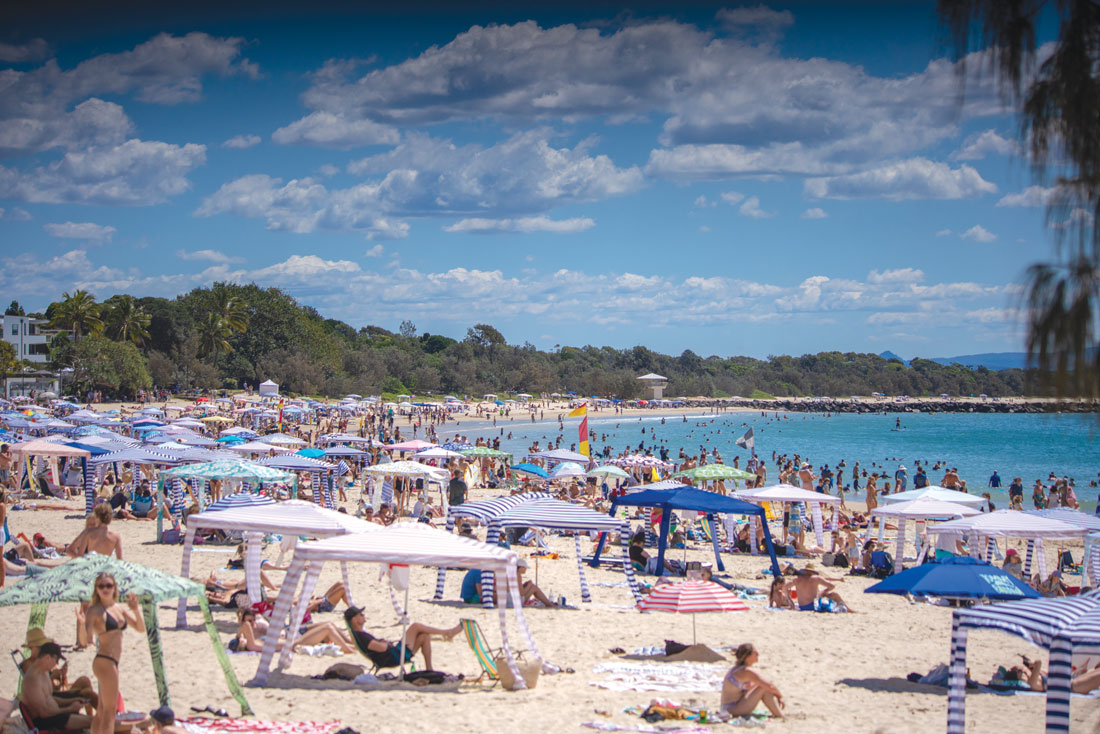
Sun Sense and Staying Alive
A sun-tanned body in minimalist clothing was part of beach culture, and for some still is, but with sunburn occurring in as little as 15 minutes and skin cancer killing an Aussie every five hours, are we more skin aware? Helen Flanagan shares her scares and compelling advice from experts.
I once wrote in a newspaper column about beach holidays with my Estonian-born mother who would slather her olive oil and vinegar concoction all over my young body several times a day, even in a heatwave. She obviously thought I was a salad!
Days later it was time to wince, as sheets of burnt skin were peeled away leaving more red skin for round two.
Later, the most popular lotion of choice was lashings of oily Hawaiian Tropic, a coconut fragrance reminiscent of a pina colada cocktail, applied between the itsy-bitsy bikini or budgie-smugglers, with a dollop of white zinc on the nose adding mucho-macho. Totally unaware of the ravages until sunscreens with SPF factors were introduced. Too late?
Segue to my latest small pale mole thought to be fine, by my ever-vigilant local GP, whose regular checks include soles of feet, scalp, ears and an explanation of the optometrist’s role to include pigmented lesions at the retina of the eye. He took a biopsy, and it came back as melanoma, a potentially lethal disease hidden below the skin.
Fast tracked to Dr Amy O’Connor, a Plastic & Reconstructive Surgeon, who ordered a PET scan, a date for surgery and explained most days she is assessing or removing skin cancers from the eyelids, lips, noses, ears, scalp and elsewhere, reconstructing to restore function and appearance.
“Melanomas have a mind of their own and surgery is the most effective treatment for both non-melanoma skin cancer and melanoma skin cancer,” she says. “Sometimes a lymph node sample will be done at the time of surgery. Depending on the individual and their skin cancer there may be other options available including surface treatment with creams or PDT (photodynamic therapy) or radiotherapy.
“Skin cancers are ultraviolet light induced growths on the skin surface which in the early stages lie on the skin surface and typically become larger and deeper over time. The majority do not spread elsewhere across the body if detected and treated early.
“They may present as an ulcer, a scaly patch, a thickening of skin, a pink nodule or a pigmented spot amongst other things. A skin spot that is changing, especially if rapid or changing colour to say brown skin spots need urgent medical attention.”
Queensland has the highest rates of skin cancer in the world and the Sunshine Coast is a particular hot spot.
“Two broad groups of skin cancer are melanoma and nonmelanoma skin cancers, the latter includes the commonest of basal cell and squamous cell,” Dr O’Connor explained adding “the risk factors for both groups include UV light exposure and sunburn from childhood, also uptake in water sports with higher incidence in swimmers, surfers and boaties and the fact our peak UV light exposure is high year-round.”
Teaching children to protect their vulnerable skin will set them up for a lifetime of sun-smart habits. Childhood sunburn is a precursor to adult sun cancer.
Have regular checks with your GP if you are worried about a spot, as early treatment has excellent outcomes.
Skin cancer diagnosis can be difficult and in the case of any uncertainty a biopsy is important. It’s wise to check the role of vitamin B3 supplements in the prevention of nonmelanoma skin cancer.
“I am passionate about offering the best possible advice based on manufacturer’s research, also increasing awareness in the community having had a serious altercation with melanoma,” comments Clint Coker, the CEO of the LiveLife Pharmacy Group, which had humble beginnings in Hastings Street and remains a magnet today for its racks of hats and sunglasses.
“Sunburn is the skin’s reaction to too much ultraviolet radiation (UVR),” he said. “You can see sunlight, you can feel heat (infrared radiation), but you can’t see or feel UVR. It can damage your skin even on cool, cloudy days.
“Get out of the sun immediately even if slightly sunburnt. Drink plenty of water or rehydration formulas, as dehydration will commonly occur. Speak to a pharmacist to help treat the burnt skin and stay out of the sun until every last sign of sunburn has gone!”
Be smart and avoid sunburn by wearing clothing such as a shirt, slop on 30+ sunscreen, slap on a hat, seek shade and slide on the sunnies. If you are out swimming or surfing, consider the time of day and the duration of sun exposure. When you’re outdoors, think sanity not vanity.”
Will I get another skin cancer?
“Commonly asked, probably yes,” answers Dr O’Connor who is actively involved in the Skin and Melanoma Multi Disciplinary Team at SCUH.
“Fifty per cent of people will get another nonmelanoma skin cancer within five years of their first diagnosis. Most people I see present with multiple skin cancers for treatment at the same time.
“Similarly, having one melanoma is a risk factor for more. Developing a skin cancer is more common as we age, however I routinely see people in their 30s and 40s with their first.”
Dr O’Connor advised after two-hours of surgery my T3A melanoma had good margins and 0-of-3 lymph nodes involved.
“Very good news but not out of the woods.”
I’ll leave the salad dressing for my lettuce.
COVER UP
The Cancer Council offers this advise for best protection:
- Slip on sun-protective clothing
- Slop on broad spectrum sunscreen, water resistant SPF30 or higher
- Slap on a hat
- Seek shade
- Slide on sunglasses that meet the Australian standards.
Keep track of the UV Index and get alerts, reminders and advice via the SunSmart App. www.cancer.org.au
Find out more Melanoma Institute Australia: www.melanoma.org.au/patientguides



